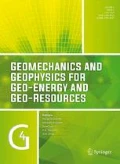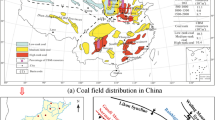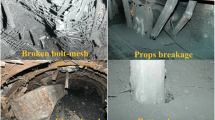Abstract
Due to differences in the properties of coal and gangue, gangue-containing coal often exhibits complex damage characteristics, which has become a key factor limiting the recovery rate in top coal caving. In order to improve the efficiency of top coal caving, it is necessary to recognize the failure mechanism of gangue-containing coal, especially the stress drop mode and the residual bearing capacity. In this paper, the post-peak mechanical properties of gangue-containing coal samples were investigated. With the aid of the PFC2D software, a model of gangue distribution in different layers of gangue-containing coal samples was established by changing the bonding properties of the balls in different layers, and triaxial numerical simulation experiments were carried out under different confining pressures. According to the Mohr–Coulomb failure criterion, a post-peak stress–strain model based on equivalent plastic strain was proposed for gangue-containing coal. The results show that the theoretical values are in good agreement with the numerical simulation values. The strength is mainly affected by the cohesive force during the first stress drop, and the effect of the internal friction angle on the strength cannot be neglected during the second stress drop. Furthermore, the brittleness characteristics of gangue-containing coal are studied. It is found that the brittleness drops rapidly when the confining pressure rises from 5 to 10 MPa, and the position of gangue has a significant impact on the softening coefficient. Finally, the quantitative relationship between the brittleness and the burst proneness was established from the perspective of energy, and the brittleness was partitioned according to the burst proneness. The research findings are beneficial for improving the recovery rate and identifying the burst proneness of coal seams to ensure safe and efficient production.
Highlights
-
The first and second stress drops are affected by the cohesion C and the internal friction angle, respectively.
-
The position of gangue has a significant impact on the softening coefficient.
-
The quantitative relationship between the brittleness and the burst proneness was established from the perspective of energy.











Similar content being viewed by others
References
Altindag R (2010) Assessment of some brittleness indexes in rock-drilling efficiency. Rock Mech Rock Eng 43:361–370. https://doi.org/10.1007/s00603-009-0057-x
Bažant ZP, Belytschko TB, Chang T-P (1984) Continuum theory for strain-softening. J Eng Mech 110:1666–1692. https://doi.org/10.1061/(ASCE)0733-9399(1984)110:12(1666)
Erickson SG, Strayer LM, Suppe J (2001) Initiation and reactivation of faults during movement over a thrust-fault ramp: numerical mechanical models. J Struct Geol 23:11–23. https://doi.org/10.1016/S0191-8141(00)00074-2
Fahimifar A, Ghadami H, Ahmadvand M (2015) The ground response curve of underwater tunnels, excavated in a strain-softening rock mass. Geomech Eng 8:323–359. https://doi.org/10.12989/gae.2015.8.3.323
Fang Z, Harrison JP (2001) A mechanical degradation index for rock. Int J Rock Mech Min Sci 38:1193–1199
Feng Z, Yang Y, Niu W, Zhao Y, Wan Z, Yao Y (2020) Permeability and meso-structure evolution of coking coal subjected to long-term exposure of triaxial stresses and high-pressure nitrogen. Geomech Geophys Geo-Energy Geo-Resour 6:1–11
Frantziskonis G, Desai C (1987) Constitutive model with strain softening. Int J Solids Struct 23:733–750. https://doi.org/10.1016/0895-7177(88)90100-8
Han J-x, Li S-c, Li S-c, Yang W, Wang L (2013a) Study of post-peak stress-strain relationship of rock material based on evolution of strength parameters. Rock Soil Mech 34:342–346. https://doi.org/10.1016/j.proeps.2012.01.049
Han J, Shucai LI, Wang L, Zhang Y, Yang W (2013b) Model for strain-softening behavior of rock mass based on generalized. Hoek-Brown Strength Criterion J Central South Univ 44:4702–4706
Hao X et al (2017) A new brittleness index for hard coal considering unsteady energy release at post-peak stage Chinese. J Rock Mech Eng 36:2641–2649
Hoek E, Brown ET (1997) Practical estimates of rock mass strength. Intjrock Mechminsci 34:1165–1186. https://doi.org/10.1016/S1365-1609(97)80069-X
Huang S, Feng X, Zhang C (2008) Study of method of comprehensive evaluation for parameters of constitutive model of rock mass Chinese. J Rock Mech Eng 27:2624–2630
Hucka V, Das B (1974) Brittleness determination of rocks by different methods International. J Rock Mech Mining Sci Geomech Abstracts 11:389–392. https://doi.org/10.1016/0148-9062(74)91109-7
Joseph T, Barron K (2003) The post-failure characteristics of rock. CIM Bull 96:66–74
Khandelwal M, Ranjith P (2010) Correlating index properties of rocks with P-wave measurements. J Appl Geophys 71:1–5
Lee Y-K, Pietruszczak S (2008) A new numerical procedure for elasto-plastic analysis of a circular opening excavated in a strain-softening rock mass. Tunn Undergr Space Technol 23:588–599. https://doi.org/10.1016/j.tust.2007.11.002
Li Q, Chen M, Jin Y, Wang F, Hou B, Zhang B (2012) Indoor evaluation method for shale brittleness and improvement. Yanshilixue Yu Gongcheng Xuebao/Chin J Rock Mech Eng 31:1680–1685
Liu H-H, Chen H, An C (2019) A criterion for evaluating the effect of shale-matrix dual-continuum flow on gas production. Geomech Geophys Geo-Energy Geo-Resour 5:87–102
Liu S, Wan Z, Zhang Y, Lu S, Ta X, Wu Z (2020) Research on evaluation and control technology of coal pillar stability based on the fracture digitization method Measurement, p 107713
Park D (2016) Rate of softening and sensitivity for weakly cemented sensitive clays. Geomech Eng 10:827–836. https://doi.org/10.12989/gae.2016.10.6.827
Potyondy DO (2015) The bonded-particle model as a tool for rock mechanics research and application: current trends and future directions. Geosyst Eng 18:1–28
Toshikazu K, Yoshio I (1981) An analysis of excavation in strain-softening rock mass Proceedings of the Japan. Soc Civil Eng 312:107–118. https://doi.org/10.2208/jscej1969.1981.312_107
Vardoulakis I (1980) Shear band inclination and shear modulus of sand in biaxial tests. Int J Numer Anal Meth Geomech 4:103–119. https://doi.org/10.1002/nag.1610040202
Yang Q, Zan Y, Xie LG (2018) Comparative analysis of the nonlinear unified strength criterion for rocks and other three-dimensional Hoek-Brown strength criteria. Geomech Geophys Geo-Energy Geo-Resour 4:29–37
Yasin Q, Du Q, Sohail GM, Ismail A (2018) Fracturing index-based brittleness prediction from geophysical logging data: application to Longmaxi shale. Geomech Geophys Geo-Energy Geo-Resour 4:301–325
Zhang H, Wan Z, Wang C, Ma Z, Zhang Y, Cheng J (2017) A statistical damage constitutive model for geomaterials under plane-strain biaxial stress state. Adv Math Phys
Zhang N, Liu C (2016) Arch structure effect of the coal gangue flow of the fully mechanized caving in special thick coal seam and its impact on the loss of top coal International Journal of. Mining Sci Technol 26:593–599
Zhang X-P, Wong LNY (2013) Crack initiation, propagation and coalescence in rock-like material containing two flaws: a numerical study based on bonded-particle model approach. Rock Mech Rock Eng 46:1001–1021
Zou J-F, Wei X-X (2018) An improved radius-incremental-approach of stress and displacement for strain-softening surrounding rock considering hydraulic-mechanical coupling. Geomech Eng 16:59–69. https://doi.org/10.12989/gae.2018.16.1.059
Zou J-F, Yang T, Ling W, Guo W, Huang F (2019) A numerical stepwise approach for cavity expansion problem in strain-softening rock or soil mass. Geomech Eng 18:225–234. https://doi.org/10.12989/gae.2019.18.3.225
Acknowledgements
The research described in this paper was financially supported by the Fundamental Research Funds for the Central Universities (2017XKZD06).
Author information
Authors and Affiliations
Corresponding author
Ethics declarations
Conflict of interest
The authors wish to confirm that there are no known conflicts of interest associated with this publication, and there has been no significant financial support for this work that could have influenced its outcome.
Additional information
Publisher's Note
Springer Nature remains neutral with regard to jurisdictional claims in published maps and institutional affiliations.
Rights and permissions
About this article
Cite this article
Liu, S., Ma, P., Meng, F. et al. Strain softening and brittleness characteristics of gangue-containing coal samples. Geomech. Geophys. Geo-energ. Geo-resour. 7, 28 (2021). https://doi.org/10.1007/s40948-021-00226-9
Received:
Accepted:
Published:
DOI: https://doi.org/10.1007/s40948-021-00226-9




